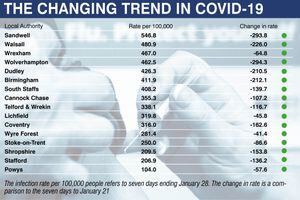Dangers remain despite Covid rate fall across West Midlands
Covid infection rates are falling sharply across the West Midlands – but dangers remain, experts warn today.

Our region is now the worst hit in England, with four out of the top 20 areas for infection to be found in the West Midlands. Sandwell now has the second highest rate in the country, despite a dramatic fall in infections.
Fellow Black Country boroughs Wolverhampton, Walsall and Dudley are also among the worst-hit areas in the country.
More rural areas are showing significantly lower infection rates, particularly the likes of Wyre Forest, Shropshire, Stafford and Powys. But even they have rates that would have been considered worryingly high back in the summer.
And with new variants now threatening, Public Health England say it is essential that lockdown rules are followed.
The figures, for the seven days to January 28, are based on tests carried out in laboratories and in the wider community.
The rates are expressed as the number of new cases per 100,000 people.
Of the 315 local areas in England, only four have seen a rise in case rates and 311 have seen a fall.

Knowsley in Merseyside continues to have the highest rate in England, with 922 new cases recorded in the seven days to January 28 – the equivalent of 611.2 cases per 100,000 people. This is down from 898.2 cases per 100,000 people in the seven days to January 21.
Sandwell in the West Midlands has the second highest rate, down from 840.6 to 546.8, with 1,796 new cases.
Slough in Berkshire is in third place, down from 807.8 to 543.0, with 812 new cases.
The four areas to record a week-on-week rise in rates are Melton, up from 203.1 to 240.2, followed by East Lindsey (102.3 to 131.9), Derbyshire Dales (225.4 to 228.1 and Oldham (253.5 to 255.6).
The continued fall in rates is starting to show in hospital admission rates, which have fallen slightly but still remain way above the peak experienced in the first wave last year. Intensive care units in our region remain under pressure.





